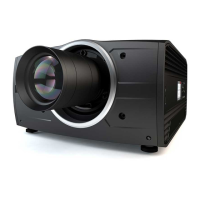4. Physical Installation
The projector lens is delivered in a separate box.
4.4 Positioning the projector
CAUTION: The po sition and physical securing of the p rojector must be su fficient to prevent it from accidental
or involuntary m ovem ent. Proper securing of the projector is the responsibility o f the installer and u ser. Th e
Projector a re heavy, and can cause severe damage and injuries if falling.
General guideline s
Proper positioning of the projector lessens the overall picture setup time, and ensures a better image with fewer artifacts.
Focus and sh arpness of the image can be adversely affected if the lens axis is not fully perpendicular to the
projection surface.
Using extended cable lengths may result in reduced image quality as well as loss of control information such
as EDID (Extended Display Information Data).
The following guidelines can help you determine the bes t physical location for the projector.
• Only install the projector on a sturdy fla t surface, or in an approved rigg
ing frame.
• Do no t ins tall the projector in a thoroughfare or another area where it is at risk o f b eing pushed or jostled.
• Allow sufficient free space around the projector for ventilation and exhaust, as desc ribed in section .
• Use the throw ratio of the installed lens as a guideline for the projector’s ph ysical distance from the s creen.
• Wherever possible, the projector lens surface should be positioned so that it is perfectly perpendicular to the center of the
screen.
Use the projector offset (lens shift), rather than physical an
gling, to correct any off-center positioning.
• Minimize the source cable length as much as possible.
In general HDBaseT and 3G-SDI are long-h aul interfaces and s uitable for bes poke installations using relatively long cables.
DP, HDMI and DVI are short-haul interfaces using pre-assembled cables with limited cable lengths.
• Limit the use of power cable extensions wherever possible. W here physical limitations necessitate their use, m ake sure that
the extension c ord has adequate surge protection and meets all electrical requirements of the connection.
• Keep the projector awa y from equ ipment that emits electromagnetic energy for example, motors, transformers and elevators.
4.5 Mounting the projector, general considerations
Mounting safety
When mounting a projector in a rig, always use an interface plate (between the projector and the mount) that has provision for a
safety wire or another safety mec hanism , to ensure that the projector does not fall down should the interface plate come loose from
the m ount.
Always screw the interface plate securely to the projector body while the projector is on the ground (i.e. cannot fall down). Then
attach proper safety wire between the interface plate and the rig before m ounting the projector in the rig
Using 3rd party mounting equipment
The pro jector has features for mounting into various system environments using 3rd party m ounts.
Four m ounting inserts are located on the bottom of projector. Th e ceiling mount ins erts have a pull-strength of more th an 4x the
weight of the projector.
The feet can be removed and threads can be used for additional mounting points. See table below for dimensions.
601–426 F70 SERIES 16/06/2017
33

